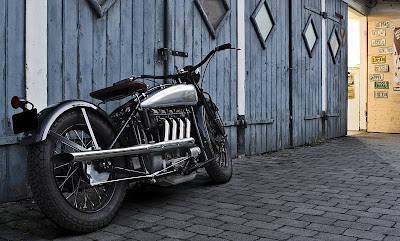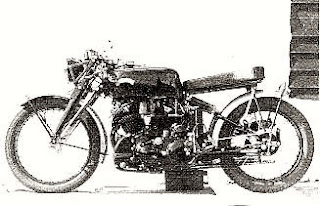 |
| Marty Dickerson on his Rapide in 1953 at the Bonneville Salt Flats |
In 1948, an eighteen year old walked into ‘Mickey’ Martin’s Burbank Vincent-HRD dealership, putting a cash deposit on the $1120 sale price of a new ‘Series B’ Touring Rapide, starting a payment plan on what was then the most expensive motorcycle in the world. The inspiration for his trip to Martin’s LA emporium were the boasts of a Vincent-owning Scotsman who spoke of leaving ‘long black streaks’ on the highway while passing cars, in third gear and 70mph no less. Readers of the late 40s motorcycle press were familiar with Vincent-HRD ads touting impossible speeds, right beside ads for x-ray glasses and miracle bodybuilding powders. Very few Americans had actually seen a Vincent, even less had ridden one to test the claims.
Marty Dickerson, the youth in question, thought the Rapide was ugly, but he “
wanted that power, wanted that speed”. He was not disappointed with his purchase, and quickly came to understand he now owned the fastest motorcycle on the planet, and soon, as young men will do, set about proving that fact to SoCal motorcyclists who believed
they had the fastest bikes. Harley Davidson had been around since the early part of the Century, as had rival Indian, and their American devotees used the collected wisdom of decades of engine-tuning to make some pretty hot bikes by the 1940s, the toughest and fastest of which tended to be ‘strokers’ with huge motors of over 100 cubic inches displacement (1600cc). Dickerson and his Vincent aroused the curiosity and pride of LA’s fastest street-racers, who formed an increasingly short line to challenge him to a ‘drag’. No matter the fame of the engine builder or skill of his rival at fast getaways, it was always Marty’s Rapide which first crossed whatever waved-sweater or crossed headlamp finish line was laid, out there on the lonely roads appropriate for such contests.
There were other ways to test speed, and the SCTA (Southern California Timing Association) provided timed evidence to bolster a reputation gained on the streets. At Muroc Dry Lake that year, Marty squeezed 118mph from his Rapide, while his buddy ‘Tex’ Luce, a Vincent mechanic fated to make his own mark on the racing world, found just a bit more, and recorded 122.04mph on the
bone-stock machine, with all lights, mudguards, and mufflers intact and present. Motorcyclists are a stubborn and loyal bunch, and the evidence of a new ‘fastest’ motorcycle didn’t translate into immediate sales. In truth, Vincent-HRD sales were dismal in California, and by June 1949, ‘Mickey’ Martin had 20 unsold Vincents languishing on his showroom floor. Knowing of Dickerson’s antics in back-road street racing, and more importantly his success at the game, Martin hatched a plan to send young Marty on a ‘tour’ of the southwest quadrant of the US, to raise awareness of the Vincent-HRD marque in the best way – nudge, wink – he knew how. Martin offered to cover all travel expenses, and take over the Rapide’s loan payments, and soon Marty Dickerson had the best possible job in the world for a 19 year old, being paid to street race all comers in small towns across America, astride the fastest production motorcycle built.
 |
| The Rapide becoming 'Californized', with a bobbed rear fender, trumpet exhaust, cowhorn 'bars... |
For one month in that summer of ’49, Marty Dickerson had the ‘
drag racing adventure of a lifetime’, covering 5000 miles through Phoenix, Dallas, Tulsa, Ft.Worth, Tyler, Kansas City, and smaller towns in Colorado and Utah. He raced the fastest motorcycles
And cars the locals could muster, sometimes legendary monsters which had never been bested. There were close calls, such as when he didn’t have time to change a fouled spark plug before a race, and the Vincent spluttered on one-and-a-half cylinders while his rival rocketed ahead. Quick thinking and a ‘poor man’s tuneup’ (downshifting from 3
rd to 2
nd at high revs to blast the plugs clean) cleared the cough and saw Marty take the lead once again. There were other times when ‘sore losers’, with much time and reputation invested in their Harleys or Hotrods, made a hasty exit the prudent choice for young Mr. Dickerson. It must have been infuriating when some short, big-nosed kid on a strange motorbike (‘Harley R Davidson?’) kept pace with the Knucklehead you’d spent months tuning for speed, until your throttle was hard on the stop while you crouched low over the tank…only to watch ‘that kid’ shift into 4
th gear, and leave you eating his dust.
The Vincent had its problems in that hard month of racing, requiring the total replacement of a clutch cable and a few engine shock absorber springs, which weren’t expecting such abuse.
Dickerson’s exploits were legend, and rumors spread like pond ripples from a cherry bomb about ‘a kid’ with a really fast Vincent, kicking butt all over the Southwest. He came and went through towns so fast nobody remembered it was ‘Marty Dickerson’ riding, he was the Street Racer with No Name, but tales of his exploits reverberate to this day, and form the actual backbone of the Vincent story in America.
On his undefeated return to LA, Dickerson was employed at Martin’s Vincent emporium as a mechanic, joining ‘Tex’ Luce and another fellow with a history of street racing and record-breaking; Rollie Free. In 1950, Free and his pal Marty took a newly delivered Vincent Black Lightning to the Bonneville Salt Flats, and set about taking records in Class ‘A’ racing, in which special fuels were used. Rollie Free raised his infamous ‘bathing suit’ record (taken at 150mph, in 1948), making his Vincent again the fastest standard motorcycle in the world, averaging over 156mph.
The salt bug bit Marty deep, and he decided to modify his trusty Rapide for higher speeds, choosing Class ‘C’ (pump gas) to avoid direct competition with his pal Rollie. The Rapides’ transformation from ‘daily rider’ to ‘salt flat racer’ was completed with Lightning parts from the Vincent factory, and a change of color scheme: she was now the ‘Blue Bike’. A new set of crankcases was required after 3 years of drag racing, and the Blue Bike gained engine cases marked ‘301’. Two years of development were required before things really came together for this machine; larger carbs and hotter cams gave a new Class ‘C’ record in 1953, averaging 147.58mph, with a fastest timed speed of 150.959mph, on pump gas, with Marty sitting on the seat (not stretched out as Rollie did), and a class-mandated 8:1 compression ratio. The Blue Bike was massaged, but all the parts were Vincent items, and the bike wasn’t so high strung that it couldn’t be ridden on the street. That 150mph record stood for over twenty years! It took a change of rules (allowing higher than 82 Octane fuel), and a hot Yoshimura Kawasaki, to break it.
Over the years, Marty continued to develop the Blue Bike, returning to Bonneville in 1976, ’80, ’86, ’96, and finally, at 67 years old for the man and 49 years the machine, in 1997. His later years competing at Bonneville were less dramatically successful than those early days, but had the important function of cementing Dickerson’s reputation among younger riders and new generations of racing enthusiasts, amazed at his stories and respectful of the legends around Marty and his Rapide. All of which happen to be true.
The number of motorcycles worldwide which have endured serious competition for 50 years can be counted on one hand. Within this very special group, machines which have taken world records at Bonneville, and cemented the reputation of an entire brand in recognizably stock form, can be counted on one finger. The Blue Bike is unique.
If you want to see it in person, the Blue Bike is on display at Altai Design in Los Angeles.































![[Trick+Trike+Spread+1.jpg]](https://blogger.googleusercontent.com/img/b/R29vZ2xl/AVvXsEjWknIUSX-uvP9UrI8ZzYhdahR3zuN7puC3g1M1QqIvZFjcQgEknT1JmZ_iXSKtWUQbjFlhA3ORmJ7uIL2sS_4OHU1C1xyPdtvd5dT9seqqf018XRcUTYeFIHr4q4Nf-i1OV9prxGNbZzo/s400/Trick+Trike+Spread+1.jpg)


















